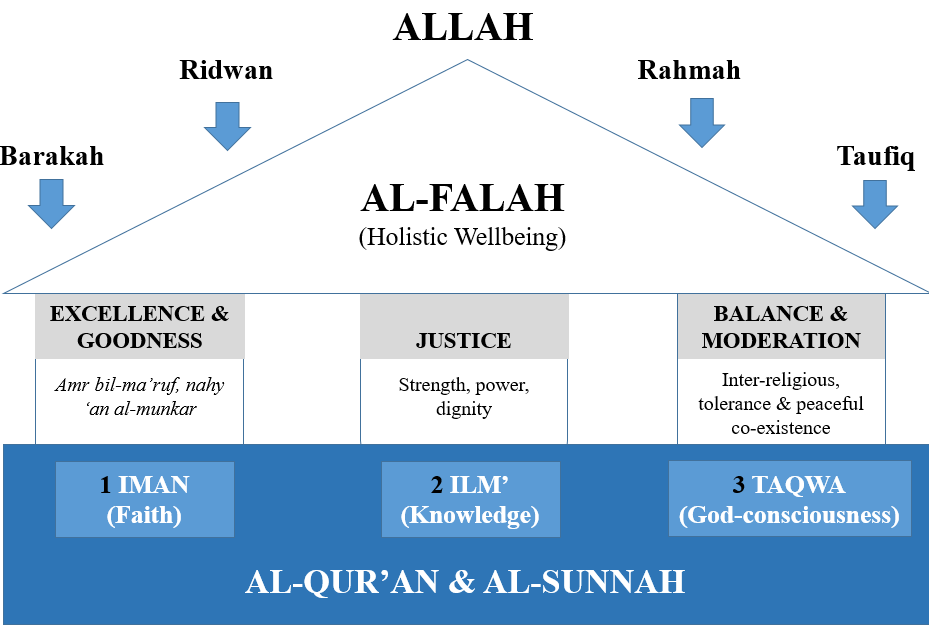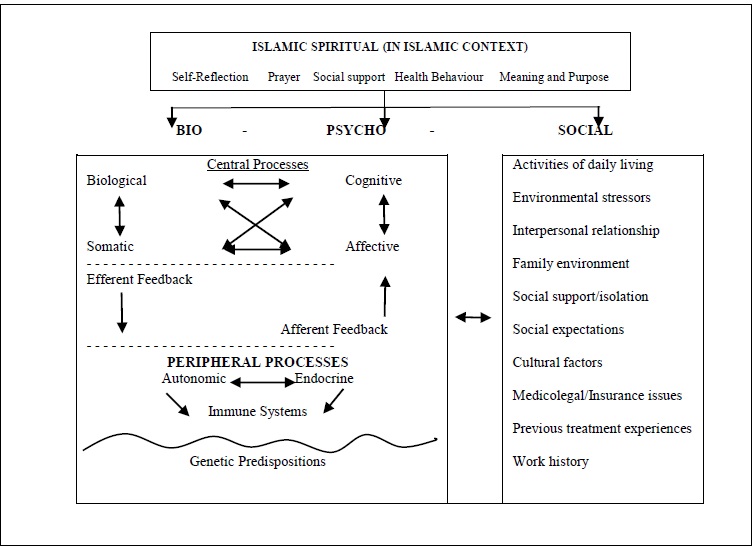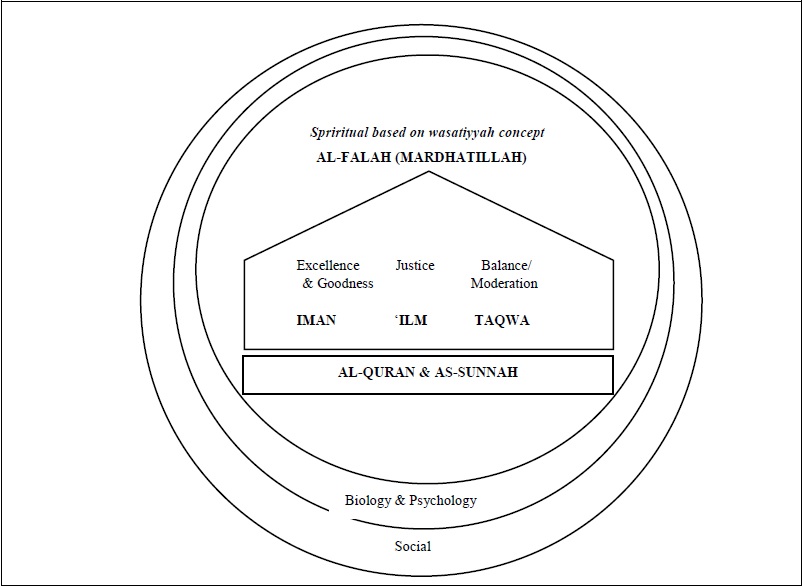Relationship Between Wasatiyyah Concept And Biopsychosocial- Spiritual Equilibrium In Managing Stress
Abstract
Stress is strongly related to the biological, psychological, social and spiritual, or sometimes known as biopsychosocial-spiritual elements in people because it is presumed to originate from the imbalance of these four elements. It is also presumed to influence the balance and health of these four elements. In order to manage stress, it is important to achieve a balance between these four elements. Hence, the question is what kind of balance should be achieved. What concept can be adopted to create this balance so that people are able to well-manage the stress-related issues and problems? This working paper aimed to determine how the concept of equilibrium (balance) and moderateness in Islam, or
Keywords: Islamic-Based Stress Managementhuman developmentwasatiyyahhuman elements
Introduction
There are various definitions of stress by numerous parties. However, all these definitions agree that stress is an individual’s response to something. This response involves the individual’s internal system, including the biological system, such as producing hormones in the body as a reaction to a particular situation that causes stress, increases the heart rate and blood circulation; the psychological system such as increasing anxiety, depression etc.; the social system that could eventually have negative effects on the primary relationships of the stressed person such as family relations, work place relations and social relations; and also the body’s spiritual system, which includes the mind, natural inclinations and emotions.
Stress occurs quite easily because individuals are exposed to sources of stress such as physical factors, for example, work load, illness or lack of nutrition; mental factors that involve hope, disappointment and fear related to one’s life; and situational factors that include roles and responsibilities such as role of a husband or wife, role of a son/daughter or role of an employee (Cosh & Tully, 2015; Heckman, Lim, & Montalto, 2014; Baghurst & Kelly, 2014; Donovan & Kleiner, 1994).
Since stress is such a vulnerable state, it has become a global issue as it could affect individuals all over the world. Stress strikes silently and leads to chaos. Hence, stress is considered a disease or a state of panic or mental confusion (Scheid & Brown, 2010). However, not all forms of stress lead to negative circumstances because there are types of stress that have positive effects. For example, stress could increase the motivation to succeed or it could help lead to self-enrichment. Stress that has a positive effect (eustress) is not the issue compared to stress that has a negative effect (distress). The question arises as to how a person could balance one’s inner self when faced with stress (Parker & Ragsdale, 2015).
The stress issue cannot be allowed to continue because it could get out of control or even cause negative effects on people, society, organization or the nation. Therefore, this paper puts forth a solution by emphasising on a harmonious concept from an Islamic perspective, which is the
Problem Statement
Before investigating the
The definition of

According to Figure
According to Quranic verse, Ali Imraan, 3:110, al-Suyutiy (2017) stated that humans were chosen by Allah SWT in accordance with the wishes of Allah SWT, who wants propriety and abstinence from despicable acts as well as a wholehearted believe in Allah SWT. The process of knowledge leads towards justice through strength, power and morality.
Al-Nawawi (n.d.) mentioned that the duty of safeguarding religion, especially by people who possess knowledge, is not an easy task because one has to safeguard the sanctity from deviations and exegesis (
Ibn Kathir (1992) elaborated about the command of Allah SWT, whereby to safeguarding religion and always uphold the truth because of Allah SWT and not because of humankind or self-pride as well as not to yield to hatred that would eventually lead to injustice towards all, friends and foe alike. According to Ibnu Kathir (1992), Allah SWT will reward all actions to those who are just and fair based from God-consciousness (
According to Hassan (2013), if the three platforms are implemented correctly, there would be added value that will be assimilated into the person during the process of seeking equilibrium in a holistic manner such as
Research Questions
What concept can be adopted to create
Purpose of the Study
This working paper purposed to determine how the concept of equilibrium (balance) and moderateness in Islam, or
Research Methods
This conceptual paper uses the revealed sources of knowledge (the Quran and Sunnah) and relevant literature to document the
Findings
The Relationship Between the
A balance from a biological, psychological, social, and spiritual aspect is important in managing stress. This is because the four elements do already exist in a person. These four elements can determine the state of health of a person in a holistic manner. If one of these elements are not in a good state, then the person cannot be said to be healthy overall. According to Sulmasy (2002), the founder of the biopsychosocial-spiritual model (known as the holistic human health safeguarding model):
A human person is a being in relationship-biologically, psychologically, socially and transcendently. The patient is a human person. Illness disrupts all of the dimensions of relationship that constitute the patient as a human person and therefore only biopsychosocial-spiritual model can provide a foundation for treating patients holistically.
This statement shows the importance of equilibrium or balance that must exist within a person. Before the

The biopsychosocial-spiritual interactive process shown by Gatchel (2004) still needs to be enhanced although the interactive process indicates a holistic interaction. In Figure
This working paper intends to substantiate the spiritual element, which is still being studied by various parties, particularly researchers including Hatala (2013) and Sulmasy (2016). Since the spiritual element is an element with reversible reactions to the three elements, it is proper to say that the spiritual element is the most important element that acts as a factor in managing stress if it is looked specifically from the scope of stress management. The spiritual element in this study will be enhanced by the

The spiritual element based on the
Ibn Kathir (1992) elaborated on the qur’anic verse (al-Baqarah, 2:155) by saying that Allah SWT tests humankind by subjecting them to several forms of misfortunes such as fear, hunger and the lack of property, soul and fruits. Thus, only those who are patient when faced with these misfortunes would receive praise and goodness from Allah SWT. The various forms of tests mentioned in the al-Qur’an are also categorised as stress from a biological (hunger), psychological (fear), social (lack of property and soul) and spiritual (the value of patience) aspect.
Through knowledge, people who face stress can evaluate situations that they face in a just manner. A just evaluation in this context means a person can think in a justified manner as to what the person faces is good or bad. If the person experiences a misfortune, the person will return the misfortune to Allah SWT. According to the citation by Ibn Kathir (1992) based on Surah al-Baqarah verse 156 and the testament by the Prophet SAW, humankind who face misfortunes and tests would mention the word that shows restitution to Allah SWT (
The Prophet SAW exhorted, meaning:
“Ummu Salamah said: I heard the Prophet SAW saying: There will not be a Muslim who faces misfortune then recites what Allah SWT has commanded him to: Verily we are owned by Allah and to HIM we will return, O Allah, give me the blessings for the misfortunes that befall us, and change it to something of goodness, as Allah would surely change it to something better” (Muslim, no. 1531).
The God-consciousness (
After faith (
Conclusion
Although Gatchel (2004) had mentioned that the spiritual element is the main instigator in the biopsychosocial-spiritual element; hence, the spiritual element highlighted in not the spiritual element in an Islamic context. Following this, the
Acknowledgments
This research work is supported by Division of Research and Innovation, Universiti Sains Malaysia (USM) under Fundamental Research Grant Scheme (FRGS), Ministry of Education Malaysia (Reference No: USM - 203/CISDEV/6711527. MOE: FRGS/1/2015/SS03/USM/02/4 – Titled Halal-Green Management Model
References
- Abdul Majid, M. K. (2013). Wasatiyyah tonggak kesatuan ummah. Kuala Lumpur: Jabatan Kemajuan Islam Malaysia.
- al-Nasafiy, ‘A. A. A. (1996). Tafsir al-nasafiy madarik al-tanzil wa haqa'iq al-ta'wil (Vol. 1). Beirut, Lubnan: Dar al-Kutub al-‘Ilmiyyah.
- al-Nawawi, I. A. Z. Y. (n.d). Tahdhib al-asma’ wa al-lughat. Beirut: Dar al-Kutub al-Ilmiyah.
- al-Qaradawi, Y. (2011). Kalimat fi al-wasatiyyah al-Islamiyyah wa maalimiha. Qahira: Misr, Dar al-Shuruq.
- al-Qurtubiy, A. ‘A. M. A. (1993). Al-jami‘li ahkam al-Qur'an (Vol. 1). Beirut, Lubnan: Dar al-Kutub al-‘Ilmiyyah.
- al-Raziy, F. D. (1990). Al-tafsir al-kabir aw mafatih al-ghayb (Vol. 2). Beirut, Lubnan: Dar al-Kutub al-‘Ilmiyyah.
- al-Salabi, A. M. (2005). al-Wasatiyyah fil al-Quran al-karim. Beirut: Dar al-Marifah.
- al-Suyutiy, J. D. (2017). The tafsirs (F. Hamza, Trans.). Accessed from http://www.altafsir.com/.
- al-Zamakhsyariy, A. Q. J. M. ‘U. M. (1995). Al-kasysyaf ‘an haqa'iq wa ghawamid al-tanzil wa ‘uyun al-aqawil fi wujud al-ta'wil (Vol. 1). M. ‘A. S. Syahin, (Ed.). Beirut: Dar al-Kutub al-‘Ilmiyyah.
- al-Zuhayliy, W. (1991). Al-tafsir al-munir fi al-‘aqidah wa al-syari‘ah wa al-manhaj (Vol. 2). Beirut, Lubnan: Dar al-Fikr al-Mu‘asir.
- Baghurst, T., & Kelley, B. C. (2014). An examination of stress in college students over the course of a semester. Health Promotion Practice, 15(3), 438-447. DOI:
- Cosh, S., & Tully, P. J. (2015). Stressors, coping, and support mechanisms for student athletes combining elite sport and tertiary education: Implications for practice. Sport Psychologist, 29(2), 120-133. DOI:
- Donovan, S. B., & Kleiner, B. H. (1994) Effective stress management. Managerial Auditing Journal, 9(6) 31-34. https://doi.org/
- Gatchel, R. J. (2004). Comorbidity of chronic pain and mental health disorders: The biopsychosocial perspective. American Psychologist, 59(8), 795-805. DOI:
- Hatala, A. R. (2013). Towards a biopsychosocial–spiritual approach in health psychology: exploring theoretical orientations and future directions. Journal of Spirituality in Mental Health, 15(4), 256-276. DOI:
- Heckman, S., Lim, H., & Montalto, C. (2014). Factors related to financial stress among college students. Journal of Financial Therapy, 5(1), 19-39. DOI: 10.4148/1944-9771.1063
- Hassan, M. K. (2013). Conceptualization on the meaning of wasatiyyah. Proceedings from Second International Conference on Terrorist Rehabilitation and Community Resilience in Singapore. Singapore: Rafles City Convention Centre.
- Ibn Kathir, H. A. F. I. (1992). Tafsir al-Qur’an al-‘Azim. Beirut, Lubnan: Dar al-Ma‘rifat.
- Miresco, M. J., & Kirmayer, L. J. (2006). The persistence of mind-brain dualism in psychiatric reasoning about clinical scenarios. American Journal of Psychiatry. 163(5), 913-918. DOI:
- Omer, S. (2015). al-Wasatiyyah and some of its implications for Islamic built environment. Pertanika Journal of Social Science & Humanities, 23(4), 995-1014.
- Parker, K. N., & Ragsdale, J. M. (2015). Effects of eustress and distress on changes in fatigue from waking to working. Applied Psychology: Health and Well-Being, 7(3), 293–315 DOI:
- Salleh, M. S. (2013). Spirituality and the new form of poverty management. International Journal of Religion & Spirituality in Society. 2(2), 89-102.
- Scheid, T. L., & Brown, T, N. (Eds.). (2010). A handbook for the study of mental health: Social contexts, theories, and systems (2nd ed.). New York: Cambridge University Press.
- Sulmasy, D. P. (2002). A biopsychosocial-bpiritual model for the care of patients at the end of life. Gerantologist, 42(3), 24-33. DOI:
- Sulmasy, D. P. (2016). Christian witness in health care. Christian Bioethics: Non-ecumenical Studies in Medical Morality. 22(1) Apr2016, 45-61. https://doi.org/
- Wan Husin, W. N. (2013). The relationship between the concept of wasatiyyah and the values of budi-Islam in reinforcing ethnic rRelations in Malaysia. International Journal of Social Science and Humanity, 3(6), 528-531. DOI:
Copyright information

This work is licensed under a Creative Commons Attribution-NonCommercial-NoDerivatives 4.0 International License.
About this article
Publication Date
23 September 2019
Article Doi
eBook ISBN
978-1-80296-067-9
Publisher
Future Academy
Volume
68
Print ISBN (optional)
-
Edition Number
1st Edition
Pages
1-806
Subjects
Sociolinguistics, linguistics, literary theory, political science, political theory
Cite this article as:
Othman, W. N. W., & Ahmad*, F. A. (2019). Relationship Between Wasatiyyah Concept And Biopsychosocial- Spiritual Equilibrium In Managing Stress. In N. S. Mat Akhir, J. Sulong, M. A. Wan Harun, S. Muhammad, A. L. Wei Lin, N. F. Low Abdullah, & M. Pourya Asl (Eds.), Role(s) and Relevance of Humanities for Sustainable Development, vol 68. European Proceedings of Social and Behavioural Sciences (pp. 253-261). Future Academy. https://doi.org/10.15405/epsbs.2019.09.27
